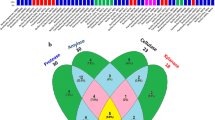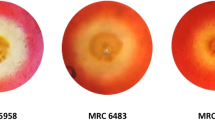Abstract
A total of 41 isolates were obtained from various samples (soil, mud, and water) of Surajkund hot spring, Jharkhand, at three different isolation temperatures of 50°C, 60°C, and 70°C. However, our interest was in the thermophilic strains that were isolated at 60°C and 70°C. Four isolates at 70°C (BITSNS038, BITSNS039, BITSNS040, BITSNS041) are the producers of thermozymes, namely amylase, xylanase, and cellulase, respectively. The highlights of the present study also showed that three out of four isolates demonstrated all three enzymatic activities, i.e. amylolytic, xylanolytic and cellulolytic on agar plate assay conditions at 70°C. One of the isolates, BITSNS038, was further chosen for phenotypic characterization as well as 16S rRNA gene sequencing and was affiliated to Geobacillus icigianus. The presence of Geobacillus icigianus was reported first time from hot spring, Surajkund, which showed amylolytic index of 1.58, xylanolytic index of 1.5 and cellulolytic index of 2.3 based on plate assay, and amylase activity of 0.81 U/mL, xylanase activity of 0.72 U/mL and very less cellulase activity of 0.15 U/mL after 24 h of growth in submerged conditions. One isolate at 60°C BITSNS024 was found to exhibit maximum amylase activity with an enzymatic index value of 3.5 and was identified as Anoxybacillus gonensis.








Similar content being viewed by others
References
Acer Ö, Matpan Bekler F, Pirinççioğlu H and Güven K 2016 Purification and characterization of thermostable and detergent-stable α-amylase from Anoxybacillus sp. AH1. Food Technol. Biotechnol. 54 70–77
Awasthi MK, Wong JW, Kumar S and Awasthi SK 2018 Biodegradation of food waste using microbial cultures producing thermostable α-amylase and cellulase under different pH and temperature. Bioresour. Technol. 248 160–170
Bin L, Zhang NN, Zhao C and Lin BX 2012 Characterization of a Recombinant Thermostable Xylanase from Hot Spring Thermophilic Geobacillus sp. TC-W7. J. Microbiol. Biotechnol. 22 1388–1394
Bhalla A, Bischoff KM and Sani RK 2015 Highly thermostable xylanase production from a thermophilic Geobacillus sp. strain WSUCF1 utilizing lignocellulosic biomass. Front. Bioeng. Biotechnol. 3 84
Bala A and Singh B 2018 Cellulolytic and xylanolytic enzymes of thermophiles for the production of renewable biofuels. Renew Energy. https://doi.org/10.1016/j.renene.2018.09.100
Bohra V, Tikariha H and Dafale NA 2019 Genomically defined Paenibacillus polymyxa ND24 for efficient cellulase production utilizing sugarcane bagasse as a substrate. Appl. Biochem. Biotechnol. 187 266–281
Cheng CL and Chang JS 2011 Hydrolysis of lignocellulosic feedstock by novel cellulases originating from Pseudomonas sp. CL3 for fermentative hydrogen production. Bioresour. Technol. 102 8628–8634
Cavello I, Urbieta MS, Segretin AB and Giaveno A 2018 Assessment of Keratinase and other hydrolytic enzymes in thermophilic bacteria isolated from geothermal areas in Patagonia Argentina. Geomicrobiol. J. 35 156–165
Derekova A, Sjøholm C, Mandeva R and Kambourova M 2007 Anoxybacillus rupiensis sp. Nov., a novel thermophilic bacterium isolated from Rupi basin (Bulgaria). Extremophiles 11 577–583
Deep K, Poddar A and Das SK 2013 Anoxybacillus suryakundensis sp. nov, a moderately thermophilic, alkalitolerant bacterium isolated from hot spring at Jharkhand, India. PloS One 8 e85493
DeCastro M, Rodríguez-Belmonte E and González-Siso MI 2016 Metagenomics of on discovery of novel thermozymes. Front. Microbiol. 7 1521
Florencio C, Couri S and Farinas CS 2012 Correlation between agar plate screening and solid-state fermentation for the prediction of cellulase production by Trichoderma strains. Enzyme Res. 2012
Gaur R and Tiwari S 2015 Isolation, production, purification and characterization of an organic-solvent-thermostable alkalophilic cellulase from Bacillus vallismortis RG-07. BMC Biotechnol. 15 19
Ghosh A, Sutradhar S and Baishya D 2019 Delineating thermophilic xylanase from Bacillus licheniformis DM5 towards its potential application in xylooligosaccharides production. World J. Microbiol. Biotechnol. 35 34. https://doi.org/10.1007/s11274-019-2605-1
Haki GD and Rakshit SK 2003 Developments in industrially important thermostable enzymes: a review. Bioresour. Technol. 89 17–34
Hou W, Wang S, Dong H and Jiang H 2013 A comprehensive census of microbial diversity in hot springs of Tengchong, Yunnan Province China using 16SrRNA gene pyrosequencing. PloS One 8 e53350
Hosseini SM and Aziz HA 2013 Evaluation of thermochemical pretreatment and continuous thermophilic condition in rice straw composting process enhancement. Bioresour. Technol. 133 240–247
Jardine JL, Stoychev S, Mavumengwana V and Ubomba-Jaswa E 2018 Screening of potential bioremediation enzymes from hot spring bacteria using conventional plate assays and liquid chromatography-Tandem mass spectrometry (Lc-Ms/Ms). J. Environ. Manage 223 787–796
Kumar B, Trivedi P, Mishra AK and Pandey A 2004 Microbial diversity of soil from two hot springs in Uttaranchal Himalaya. Microbiol. Res. 159 141–146
Kasana RC, Salwan R, Dhar H and Dutt S 2008 A rapid and easy method for the detection of microbial cellulases on agar plates using Gram’s iodine. Curr. Microbiol. 57 503–507
Kaláb M, Yang AF and Chabot D 2008 Conventional scanning electron microscopy of bacteria. Infocus magazine. 10 42–61
Kaur A, Mahajan R, Singh A and Garg G 2010 Application of cellulase free xylano-pectinolytic enzymes from the same bacterial isolate in biobleaching of kraft pulp. Bioresour. Technol. 101 9150–9155
Kurosawa N 2013 Discovery of thermostable enzymes from hot environmental samples by metagenomic approaches; in Thermophilic Microbes in Environmental and Industrial Biotechnology: Biotechnology of Thermophiles (eds) Satyanarayana T, Littlechild J and Kawarabayasi Y (Springer, Dordrecht) pp 413–27
Kumar M, Yadav AN, Tiwari R and Prasanna R 2014 Deciphering the diversity of culturable thermotolerant bacteria from Manikaran hot spring. Ann. Microbiol. 64 741–751
Kumar S, Stecher G and Tamura K 2016 MEGA7: molecular evolutionary genetics analysis version 7.0 for bigger datasets. Mol. Biol. Evol. 33 1870–1874
Kambourova M 2018 Thermostable enzymes and polysaccharides produced by thermophilic bacteria isolated from Bulgarian hot springs. Eng. Life Sci. 18 758–767
Loperena L, Soria V, Varela H and Lupo S 2012 Extracellular enzymes produced by microorganisms isolated from maritime Antarctica. World J. Microbiol. Biotechnol. 28 2249–2256
Madhavan A, Sindhu R, Binod P, Sukumaran RK and Pandey A 2017 Strategies for design of improved biocatalysts for industrial applications. Bioresour. Technol. 245 1304–1313
Mohammad BT, Al Daghistani HI, Jaouani A, Abdel-Latif S and Kennes C 2017 Isolation and Characterization of Thermophilic Bacteria from Jordanian Hot Springs: Bacillus licheniformis and Thermomonas hydrothermalis Isolates as Potential Producers of Thermostable Enzymes. Int. J. Microbiol. 2017
Nelson N 1944 A photometric adaptation of the Somogyi method for the determination of glucose. J. Biol. Chem. 153 375–380
Narang S and Satyanarayana T 2001 Thermostable α‐amylase production by an extreme thermophile Bacillus thermooleovorans. Lett. Appl. microbial. 32 31–35
Nagar S, Mittal A and Gupta VK 2012 A cost effective for screening and isolation of xylan degrading bacteria using agro waste material. Asian J. Biol. Sci. 5 384–394
Naili B, Sahnoun M, Bejar S and Kammoun R 2016 Optimization of submerged Aspergillus oryzae S2 α-amylase production. Food Sci. Biotechnol. 25 185–192
Poddar A, Lepcha RT and Das SK 2014 Taxonomic study of the genus Tepidiphilus: transfer of Petrobacter succinatimandens to the genus Tepidiphilus as Tepidiphilus succinatimandens comb. nov., emended description of the genus Tepidiphilus and description of Tepidiphilus thermophilus sp. nov., isolated from a terrestrial hot spring. Int. J. Syst. Evol. Microbiol. 64 228–235
Panda AK, Bisht SS, Mandal S and Kumar NS 2016 Bacterial and archeal community composition in hot springs from Indo-Burma region, North-east India. Amb. Express 6 111
Panosyan HH 2017 Thermophilic bacilli isolated from armenian geothermal springs and their potential for production of hydrolytic enzymes. Int. J. Biotech & Bioeng. 3 248–253
Paul JS, Lall BM, Jadhav SK and Tiwari KL 2017 Parameter’s optimization and kinetics study of α-amylase enzyme of Bacillus sp. MB6 isolated from vegetable waste. Process Biochem. 52 123–129
Pandey BR, Ghimire S, Bhattarai S and Shrestha BG 2019 Isolation, growth, enzyme assay and identification via 16S rRNA full sequencing of cellulolytic microbes from Nepal for biofuel production. Renew Energy 132 515–526
Saitou N and Nei M 1987 The neighbor-joining method: a new method for reconstructing phylogenetic trees. Mol. Biol. Evol. 1987 4 406–425
Stout LM, Blake RE, Greenwood JP and Martini AM 2009 Microbial diversity of boron-rich volcanic hot springs of St. Lucia, Lesser Antilles. FEMS Microbiol. Ecol. 70 402–412
Saxena R, Dhakan DB, Mittal P and Waiker P 2017 Metagenomic analysis of hot springs in Central India reveals hydrocarbon degrading thermophiles and pathways essential for survival in extreme environments. Front. Microbiol. 7 2123
Sari B, Faiz O, Genc B and Adiguzel G 2018 New xylanolytic enzyme from Geobacillus galactosidasius BS61 from a geothermal resource in Turkey. Int. J. Biol. Macromol. 119 1017–1026
Sudan SK, Kumar N, Kaur I and Sahni G 2018 Production, purification and characterization of raw starch hydrolyzing thermostable acidic α-amylase from hot springs, India. Int. J. Biol. Macromol. https://doi.org/10.1016/j.ijbiomac.2018.05.231
Tanyildizi MS, Elibol M and Ozer D 2006 Optimization of growth medium for the production of α‐amylase from Bacillus amyloliquefaciens using response surface methodology. J. Chem. Technol. Biotechnol. 81 618–622
Vaikundamoorthy R, Rajendran R, Selvaraju A and Moorthy K 2018 Development of thermostable amylase enzyme from Bacillus cereus for potential antibiofilm activity. Bioorg. Chem. 77 494–506
Verma R, Bhalla A and Kumar S 2018 Valorization of Lignocellulosic residues for cost-effective production of thermo-alkali-stable xylanase by Geobacillus thermodenitrificans X1 of Indian Himalayan hot spring. Waste Biomass Valorization 1–11
Warne RW 2014 The micro and macro of nutrients across biological scales. Integr. Comp. Biol. 54 864–872
Van Den Burg B 2003 Extremophiles as a source for novel enzymes. Curr. Opin. Microbiol. 6 213–218
Acknowledgements
SS is supported by DBT-JRF fellowship sponsored by the Department of Biotechnology, India. The authors are also sincerely thankful for the technical assistance of Central Instrumentation Facility, Birla Institute of Technology, Mesra, and Microbial Type of Culture Collection, Institute of Microbial Technology, Chandigarh, India.
Author information
Authors and Affiliations
Corresponding author
Rights and permissions
About this article
Cite this article
Soy, S., Nigam, V.K. & Sharma, S.R. Cellulolytic, amylolytic and xylanolytic potential of thermophilic isolates of Surajkund hot spring. J Biosci 44, 124 (2019). https://doi.org/10.1007/s12038-019-9938-7
Published:
DOI: https://doi.org/10.1007/s12038-019-9938-7




